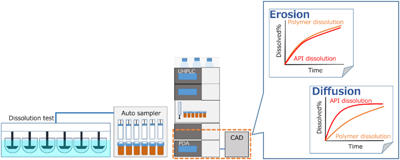- 著者
- Mariko Kimoto Toshiyasu Sakane Hidemasa Katsumi Akira Yamamoto
- 出版者
- The Pharmaceutical Society of Japan
- 雑誌
- Chemical and Pharmaceutical Bulletin (ISSN:00092363)
- 巻号頁・発行日
- vol.70, no.2, pp.138-145, 2022-02-01 (Released:2022-02-01)
- 参考文献数
- 25
- 被引用文献数
- 1
The dissolution behaviors of base excipients from sustained-release formulations have been investigated using various methodologies. However, the dissolution of polymers has not been fully evaluated because differences between formulations are still verified only by the release of active pharmaceutical ingredients (APIs). In our previous study, we proposed a quick and simultaneous analysis of dissolved APIs and water-soluble polymers by ultra HPLC using charged aerosol and photodiode array detectors. The purpose of this study was to verify whether the analysis system could be adapted to other water-soluble polymers. Dissolution tests were conducted using matrix model tablets prepared from three polymers and three APIs (propranolol, ranitidine, and cilostazol) with different solubilities. The dissolution profiles of the polymers and APIs were determined using the proposed analysis system and compared. The results clarified differences in the dissolution behaviors of the APIs and polymers. The polymers, especially hydroxypropyl cellulose, exhibited the dissolution properties characteristic of each model formulation. Propranolol and ranitidine showed the diffusion type, while cilostazol showed the erosion type release mechanism due to their different solubilities. The release of cilostazol was delayed in all models compared to the polymer, which may be due to the aggregation of cilostazol in the gel layer. This analytical method can be used to study the dissolution behavior (diffusion or erosion) of APIs from matrix tablets containing various polymers. This method will provide useful information on release control, which will make it easier and more efficient to design appropriate formulations and analyze the release mechanisms.
